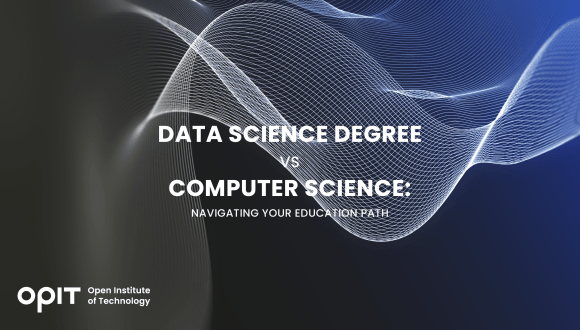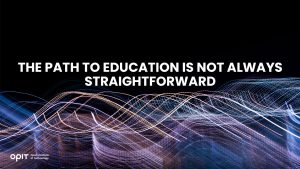

What you study typically dictates your future career. Picking an academic subject is a decision that pairs your passion with practicality, particularly in the computer science and data science fields.
If you’re at a crossroads between choosing one or the other, think about which path aligns with your interests and gives you the best chance of building a bright digital future.
Understanding the Core of Computer Science
Computer science is the backbone of technology. This field prepares you for understanding how software and systems work. It teaches the basics of coding and the complexities of algorithms and network security, all within the same field.
It’s a broad discipline with a knack for problem-solving and innovative thinking. When you master it, you might be crafting the next big app or securing cyber spaces for major companies.
Diving Into Data Science
In contrast, data science zooms in more closely on the digital age’s most precious resource: data. A degree in data science equips you with the knowledge to sift through mountains of information and extract insights that can be used in various industries. For example, it could help healthcare professionals uncover patterns in patient care, sports agents devise new strategies based on big data, or businesses to plan out a targeted marketing campaign.
Data science is about pattern recognition, predictive modeling, and telling stories through data visualization. It’s where statistics meet strategy and empower those in decision-making positions with actionable intelligence.
Comparing Curriculums: Computer Science vs Data Science Degree
Both degrees share a foundation in math and analytical thinking in terms of curricula. Regardless, they have distinct differences:
- Computer Science students are immersed in programming languages, software engineering principles, and computing theory. Their tasks consist primarily of building, designing, and optimizing systems.
- Data Science coursework, on the other hand, mixes together statistics, machine learning, data visualization, and ethical considerations in data handling. It focuses on the lifecycle of data analysis, from collection to communication.
- Each curriculum imparts the basic and advanced technical skills and fosters critical thinking. Once they graduate from either course, graduates will have the means to handle complex problems with creative solutions.
Career Trajectories: Data Science Degree vs Computer Science
Graduates from both fields are in high demand, but the roads they travel can look quite different.
- Computer Science aficionados might be developing software, protecting users against cyber threats, patching and upgrading existing systems, or designing new computing hardware.
- Data Science experts are likely to take on roles like data analysis, predictive modeling, or AI and machine learning engineering.
Fortunately, neither choice will leave you wanting in terms of salary. The sectors are thirsty for the talent and prepared to pay well for the best talent. The salary shouldn’t affect your choice, but whether your passion lies in creation versus analysis.
For instance, in Germany, you’re looking at an average salary of about €50,000 ($54,635) as of 2024. When you compare these numbers to the tech field in the U.S., salaries in countries like the U.K., Poland, France, Germany, and Spain range from 34% to 63% of what their counterparts make in the U.S. If you’re in the tech industry in Europe, what you take home can vary quite a bit depending on where you are.
In the U.K., the average salary for data scientists as of 2024 is around $67,254 per year, with potential additional compensation bringing it up to $79,978. Meanwhile, in Germany, the median salary for a data scientist is just slightly less, around €66,000 ($72,111) per year.
Educational Prerequisites and Learning Outcomes
Before enrolling into either of these fields, you must have a solid base in mathematics and a talent for problem-solving. More specifically, computer science aspirants should get ready for high-level programming, so basic familiarity with programming logic, languages (any would help), and algorithms will do wonders. Just as importantly, you should also have a strong grip on logical reasoning.
Furthermore, data science enthusiasts will need to have a solid understanding of statistics and a knack for critical thinking. Graduates from both fields emerge as tech-savvy professionals who can tackle tomorrow’s challenges with a deep understanding of tech nuances.
OPIT’s Approach to Technology Education
OPIT is at the heart of technology education. The service offers MSc in Applied Data Science and AI and BSc in Modern Computer Science. Both programs have the future in mind, yours and of that of the tech industry as a whole. The programs mix theoretical knowledge with hands-on experience to meet the demands of the job market.
They diverge in focus but converge in aim: to forge skilled professionals ready to make an impact. Best of all, the programs set themselves apart from the traditional classroom education with personalized study that you can do at your own time, without constrictive exams. Instead, the programs focus on continuous learning.
Making Your Decision: Factors to Consider
Now, while you might have a better understanding of what each field represents, there’s a lot more to it. The choice between data science and computer science hinges on a few factors:
- Decide if you are more interested by the prospect of developing software or deciphering data patterns.
- Think about where you see yourself in the tech industry and the type of projects that excite you.
- Keep an eye on the future, understand which skills are likely to remain in high demand, and whether they suit you.
- These considerations can put you on track for a degree that fuels your passion and boosts your career prospects.
Two Options, One Choice
Data science and computer science degrees are both lucrative, in demand, creative, and engaging careers. More than simply academic choices, they will determine what professions you can enter and your future opportunities. Ultimately, your interests, skills, and strengths should decide which path you take. Both pay well and both reward hard work, so choose wisely. Either way, the possibilities are vast and continue to grow by the day.
Related posts

Life is unpredictable. While many of us have specific hopes and expectations of how our futures will turn out, things don’t always go as expected. There are many variables and unexpected incidents that can interfere and force you to alter your plans, and this is particularly true when it comes to education.
For instance, you might have had plans to study a specific subject, but had to deviate from those plans due to unforeseen circumstances. Or you may have had to enter the workforce in an occupation different from the one you sought in an effort to earn an income, a move that may not provide you with the time or opportunity to achieve your desired educational aims.
In short, every individual’s career pathway is different, and very few go exactly as we expect from the outset. Fortunately, even if you experience a few false starts or sudden twists in your pathway, there are always options available to help you get back on track.
The Unpredictable Nature of Education
In theory, the educational process seems simple. You select a course of study that interests you from the vast array of subjects and prospective professions, select the appropriate classes, acquire the knowledge and skills you need to succeed, and then embark on your profession.
In reality, however, as many people know from firsthand experience, the road to education is often far from straightforward. Here are just some of the many challenges that can take your educational path in a completely different direction:
- Life’s Curveballs: As touched on in the introduction, life is impossible to predict. Financial hardships, health issues, and family emergencies are just some of the unfortunate occurrences that might derail even the most perfectly planned educational regime.
- Changing Interests: People’s desires and preferences don’t necessarily stay the same throughout their entire lives. As you grow, learn, and have new experiences, your interests may change, and so, too, may your educational objectives.
- Pressure and Burnout: Some academic paths are particularly challenging, demanding intense levels of study and hard work. This can sometimes prove too much to bear, even for the most resilient students.
- Failures and Setbacks: Conventional education largely builds around tests and examinations, requiring students to demonstrate their competencies repeatedly. It’s a system that doesn’t suit everyone, and test failures can lead to setbacks and delays.
- Inequality: People can be born with very different privileges and levels of access to education. Those in certain parts of the world may find it much more challenging to complete their education path for financial, cultural, or even political reasons.
- Late Bloomers: People develop at different paces. Some may struggle educationally early on in their lives, forcing them to make certain concessions or sacrifices related to their studies, only to find their feet later in life once they’ve entered the world of work.
Whether you’re a late bloomer, have had your educational aspirations delayed by personal problems, desire to learn new skills and try something different, or want to begin a fresh chapter in your professional life, the Open Institute of Technology (OPIT) may be able to help.
Introducing OPIT
OPIT is an online teaching platform, making high-level technological educational programs accessible to all, no matter their age or background. Offering education in fields like computer science, artificial intelligence, and digital business, OPIT provides a curated collection of degrees. In addition, they offer classes taught by world-leading tutors imparting the wisdom and skills students need to achieve their goals and become the tech leaders of tomorrow.
Meanwhile, for those who have had somewhat tumultuous or unpredictable educational paths, OPIT offers the perfect course corrector: the OPIT Foundation Year.
The OPIT Foundation Year
OPIT’s Foundation Year is a Pre-Tertiary Certificate in Information Technology, fully aligned with MQF/EQF Level 4 standards and valued at 60 ECTS credits. Lasting just one year, this program essentially serves as a comprehensive yet accessible springboard towards higher-level education, creating a path towards degrees and careers in dynamic, flexible fields, like computer science and digital business.
Like other OPIT programs, the Foundation Year is delivered entirely online via the OPIT Virtual Learning Environment. Combining live lectures, asynchronous content, and interactive assessments, students enjoy diverse and dynamic study experiences, acquiring core skills like academic writing, mathematics, and computer literacy, and building a bedrock of knowledge and confidence before taking their next steps.
Who Is the Foundation Program For?
The Foundation Program is designed to provide a solid base upon which to build the technological education many students need. It’s the perfect choice for those who are eager and ambitious to enter professions in AI, data science, and computing, but don’t feel that they have the necessary core skills and knowledge needed to dive straight into a degree.
Entry requirements are relatively relaxed in order to allow as many students as possible to enjoy the benefits of this program. With that said, applicants should ideally hold an MQF/EQF Level 3 or equivalent qualification, with the intention of pursuing a bachelor’s degree. A minimum of B2 level of English proficiency is also required, as this is the working and studying language of the institution.
What the Foundation Year Provides
Perhaps you’ve recently graduated, are considering a career change, or finally have the opportunity to return to education after initial delays or unexpected disruptions to your original plans. Either way, the Foundation Year can help you enjoy:
- Greater Self-Confidence: Foundation Year graduates gain the fundamental skills they need to enter degree programs with much more self-belief and assuredness.
- Superior Tech Knowledge: Lasting two terms, this course explores mathematics, academic reading and writing, and provides an introduction to computer hardware and software.
- Foundational Mathematics: Mathematics literacy forms a large part of the study focus for the Foundation Year, helping students feel more comfortable with numbers and formulas.
- Flexible Learning: Unlike more rigid, conventional education environments, OPIT gives you the freedom and flexibility to study at a pace that suits you best, all from the comfort of home.
- Global Community: OPIT is an international institution, with staff and students from all around the world eager to share knowledge, exchange ideas, and help one another.
Take Your Next Steps to Success With the OPIT Foundation Year
If you’re curious about a career in technology or have always wanted to work with AI, data, and computers, but struggled to find the time and opportunities you need to acquire relevant skills and knowledge, the Foundation Program was made for people like you.
It’s the ideal entry point into the exciting world of online education, and the perfect first step towards a prestigious degree from an innovative and increasingly successful institution. Download the brochure to learn more about it, or start your online application, today.

Students today have a broader range of fields of study to choose from than ever before, but with the world becoming increasingly technological and computers increasing in influence and importance, pursuing a career in computer science often proves a smart, strategic choice.
There are numerous benefits and career paths associated with studying and working in computer science, and we’ll be listing just a few of them in this guide.
High Average Salaries
With the rising cost of living in many parts of the world, it’s unsurprising that many students are thinking several decades ahead to determine what level of starting salaries they could obtain in different career fields.
Many are also seeking professions that offer the opportunity for growth and the ability to advance up the ranks over time, thus increasing their salary and their quality of life in the process.
If a strong, stable salary with the opportunity for improved income is one of your top career priorities, computer science should be at or near the top of your list of prospective careers.
According to recent data, computer scientists earn an average of over €65,000 per year, with certain jobs, like IT project leader and data scientist, paying ever higher. Starting salaries are strong, too, with graduates earning anywhere from €46,000 to €60,000, depending on their chosen profession and level of qualifications.
There are similarly high average salaries reported around the world in computer science and related fields such as data science and AI/ML engineering. These numbers are projected to increase in the years to come, pointing to computer science as a way for graduates to get off to the best financial start of any career.
Unrivaled Flexibility
A common problem with some subjects and courses is that they only provide graduates with a narrow set of skills and a similarly narrow range of potential professions to which they can apply those skills.
That’s not the case with computer science. Graduates in this field can enjoy instant access to a remarkably diverse array of career opportunities, with even newer opportunities being created all the time as technology evolves and innovations emerge.
A few of the many industries and roles you might choose to enter in the field of computer science include:
- Healthcare: As a software developer, data analyst, or cybersecurity expert
- Finance: As a fintech engineer, blockchain developer, or security analyst
- Media: As a graphics programmer, AI developer, or game developer
- Education: As an analyst, software developer, or machine learning engineer
Guaranteed Opportunities
Some career paths are more limited than others, with relatively low numbers of opportunities, recurring risks of job loss, or difficulty obtaining employment in the first place.
Again, with computer science, this simply isn’t the case. At a time when 75% of companies plan to embrace AI and other technologies by 2027, and businesses of all sizes and industries are now relying on computers more than ever before, computer science graduates can enjoy almost unbeatable job security.
Opportunities will continue to grow for people with good computing knowledge, whether that be in the obvious fields like software and web development, engineering, and AI development, or more niche sectors.
With so many options, you’re effectively guaranteed a long, rewarding career if you put in the necessary time and effort needed to establish a strong foundation of computing skills.
Rapidly Expanding and Evolving Industries
It’s no secret that the world of technology is a dynamic and fast-moving one. In the past 20 years alone, we’ve seen the proliferation of the internet, the rapid advancement of smartphones and wearable devices, the emergence of AI, and so much more.
In the years ahead, engineers and developers will continue to explore the boundaries of modern technology’s powers and potential, driving new innovations and improvements and opening more exciting job opportunities for those already established and experienced in this field.
Getting into computer science now could therefore provide a solid foundation for a career filled with excitement as you uncover and explore new ways of working with computers in fields as diverse as healthcare, finance, education, entertainment, manufacturing, logistics, and beyond.
Start Your Computer Science Career at OPIT
We’ve discussed some of the many benefits associated with careers in computer science, from the high starting salaries to the rapidly growing array of job options available to graduates. By now, you may be eager to follow this particular career path and take advantage of the wealth of opportunities.
If you’re wondering how to start, the Open Institute of Technology (OPIT) may hold the answers you need. As an exclusively online learning platform, specializing in computer science and digital business, and staffed by some of the world’s leading tech experts, OPIT is producing the tech leaders of tomorrow.
Some of the many advantages of learning with OPIT include:
- Accessible and flexible online education that matches your learning style and schedule
- Heavy focus on real-world applications of the skills you acquire
- An international community of like-minded students from around the globe
- A top team of tutors and lecturers from varying fields and industries
- Progressive assessment of skills and understanding – not constant exams
OPIT offers a small, curated selection of courses for those seeking to gain the technological skills and knowledge to succeed in their chosen areas of expertise. That includes a BSc (Hons) in Computer Science – a six-term program, worth 180 ECTS credits.
Numerous IT industry leaders and experts helped develop this fully accredited undergraduate degree, which is online and accessible to all. Like other OPIT courses, it offers a flexible learning program, with progressive assessments, fast-track options, and the opportunity to be part of a growing community of learners and tutors.
If the benefits of doing a career in computer science interest you, download the OPIT BSc in Computer Science brochure or fill out an online application today and take your first step toward a rewarding and fulfilling profession.
Have questions?
Visit our FAQ page or get in touch with us!
Write us at +39 335 576 0263
Get in touch at hello@opit.com
Talk to one of our Study Advisors
We are international
We can speak in:


